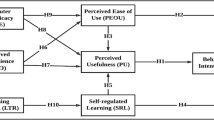Abstract
Given the popularity of webcasts and their educational benefits as stressed in previous research, this paper investigates students’ acceptance and continued use of webcasts in an undergraduate course. Furthermore, the study explores the determinants of students’ webcast use by employing the well-validated Technology Acceptance Model (TAM) of Davis (MIS Quarterly 13(3):319–339, 1989). To this, a temporal dimension was added, as TAM focuses on students’ initial expectations and attitudes before using a tool. Hence, it remains unclear how these expectations and attitudes change when a student is exposed to the webcasts and how these changed perceptions and attitudes explain students’ continued use. The current study attempts to address this by capturing both students’ initial expectations and attitudes prior to exposure and their perceptions and attitudes during exposure. Students’ (n = 120) webcast usage was captured by logging the number of hits and the duration spent viewing the webcasts. Results reveal that, although many students accepted webcasts, only a few continued to use them. Contrary to the TAM model, students’ initial adoption was not influenced by their initial attitudes and expectations. Students’ continued use was only influenced by their perceptions of usefulness. This data illustrates that, although students were positive towards the webcasts, they only used them after they acknowledged the functionality of such a tool in supporting the learning process.







Similar content being viewed by others
Notes
A tool is, in light of the TAM, largely defined. It encompasses all the possible information technology applications.
References
Acharya, C. (2003). NUCast survey. Paper presented at the conference on human factors in computing systems, Montreal, Canada. Retrieved August 22, 2010 from https://team.nus.edu.sg/cdtl/staff/Research/CDTLMSNo_4.pdf.
Behling, O., & Law, K. S. (2000). Translating questionnaires and other research instruments, problems and solutions. Thousand Oaks, CA: Sage Publications.
Bhattacherjee, A. (2001). Understanding information systems continuance: An expectations-confirmation model. MIS Quarterly, 25(3), 351–370.
Bongey, S. B., Cizaldo, G., & Kalnbach, L. (2006). Explorations in course-casting: Podcasts in higher education. Campus-wide Information Systems, 23(5), 350–367.
Brotherton, J., & Abowd, G. (2004). Lessons learned from eclass: Assessing automated capture and access in the classroom. ACM Transactions on Computer-Human Interaction, 11(2), 121–155.
Chan, A. Y., Chow, K., & Jia, W. (2003). A Framework for evaluation of learning effectiveness in online courses. In R. W. Lau, Q. Li, R. Cheung, & W. Liu (Eds.), Advances in web-based learning -ICWL 2005 (Vol. 2783, pp. 383–395). Hong Kong, China: Springer.
Cho, V., Cheng, E. T., & Lai, J. W. (2009). The role of perceived user-interface design in continued usage intention of self-paced e-learning tools. Computers & Education, 53(2), 216–227.
Clark, R. E. (1983). Reconsidering research on learning from media. Review of Educational Research, 53(4), 445–459.
Copley, J. (2007). Audio and video podcasts of lectures for campus-based students: Production and evaluation of student use. Innovations in Education and Teaching International, 44(4), 387–399.
Cramer, K. M., Collins, K. R., Snider, D., & Fawcett, G. (2007). The virtual lecture hall: Utilization, effectiveness and student perceptions. British Journal of Educational Technology, 38(1), 106–115.
Dabbagh, N., & Kitsantas, A. (2005). Using web-based pedagogical tools as scaffolds for self-regulated learning. Instructional Science, 33(5), 513–540.
Davis, F. D. (1989). Perceived usefulness, perceived ease of use, and user acceptance of information technology. MIS Quarterly, 13(3), 319–339.
Davis, F. D. (1993). User acceptance of information technology: System characteristics, users perceptions, and behavioral impacts. International Journal of Man Machine Studies, 38(3), 475–487.
Day, J., & Foley, J. (2006). Evaluating web-lectures: A case study from HCI. Paper presented at the conference on human factors in computing systems, Montreal, Canada. Retrieved August 22, 2010 from http://portal.acm.org/citation.cfm?id=1125493.
Doll, W. J., Hendrickson, A., & Deng, X. (1998). Using Davis’s perceived usefulness and ease of use instruments for decision making: a confirmatory and multigroup invariance analysis. Decision Sciences, 29(4), 839–869.
Doyle, W. (1977). Paradigms for research on teacher effectiveness. Review of Research in Education, 5, 392–431.
Evans, C. (2008). The effectiveness of m-learning in the form of podcast revision lectures in higher education. Computers & Education, 50(2), 491–498.
Fazio, R. H., Zanna, M. P., & Cooper, J. (1978). Direct experience and attitude-behavior consistency: An information processing analysis. Personality and Social Psychology Bulletin, 4(1), 48–51.
Fishbein, M., & Ajzen, I. (1980). Understanding attitudes and predicting social behavior. New Jersey: Prentice Hall.
Freeman, M. (1998). Video conferencing: a solution to the multi-campus large classes problem? British Journal of Educational Technology., 29(3), 197–210.
Goldberg, H. R., & McKhann, G. M. (2000). Student test scores are improved in a virtual learning environment. Advances in Physiological Education, 23(1), 59–66.
Green, S. M., Voegeli, D., Harrison, M., Philips, J., Knowles, J., Weaver, M., et al. (2003). Evaluating the use of streaming video to support student learning in a first-year life science course for student nurses. Nurse Education Today, 23(4), 255–261.
Hair, J. F., Black, W. C., Babin, B. J., & Anderson, R. E. (2010). Multivariate data analysis, a global perspective (Seventh ed.). New Jersey: Pearson Prentice Hall.
Harley, D., Henke, J., Lawrence, S., McMartin, F., Maher, M., Gawlik, M., et al. (2003). Costs, culture, and complexity: An analysis of technology enhancements in a large lecture course at UC Berkeley. Retrieved August 22, 2010 from University of California, Berkeley, Center for Studies in Higher Education. http://repositories.cdlib.org/cshe/CSHE3-03.
Hew, K. F. (2009). Use of audio podcast in K-12 and higher education: A review of research topics and methodologies. Educational Technology Research Development, 57(3), 333–357.
Hung, H., & Cho, V. (2008). Continued usage of e-learning communication tools: A study from the learners’ perspective in Hong Kong. International Journal of Training and Development, 12(3), 171–187.
Ifinedo, P. (2006). Acceptance and continuance intention of web-based learning technologies (WLT) use among university students in a Baltic country. The Electronic Journal on Information Systems in Developing Countries, 23(6), 1–20.
Karahanna, E., Straub, D. W., & Chervany, N. L. (1999). Information technology adoption across time: A cross-sectional comparison of pre-adoption and post-adoption beliefs. MIS Quarterly, 23(2), 183–213.
Klobas, J. E. (1995). Beyond information quality: Fitness for purpose and electronic information resource use. Journal of Information Science, 21(2), 95–114.
Legris, P., Ingham, J., & Collerette, P. (2003). Why do people use information technology? A critical review of the technology acceptance model. Information & Management, 40(3), 191–204.
McKinney, D., Dyck, J. L., & Luber, E. S. (2009). iTunes University and the classroom: Can podcasts replace professors? Computers & Education, 52(3), 617–623.
Moss, N. D., O’Connor, E. L., & White, K. M. (2010). Psychosocial predictors of the use of enhanced podcasting in student learning. Computers in Human Behavior, 26(3), 302–309.
Ngai, E. W. T., Poon, J. K. L., & Chan, Y. H. C. (2007). Empirical examination of the adoption of WebCT using TAM. Computers & Education, 48(2), 250–267.
Nunnally, Y. J. (1978). Psychometric theory. New York: McGraw Hill.
Scutter, S., Stupans, I., Sawyer, T., & King, S. (2010). How do students use podcasts to support learning? Australasian Journal of Educational Technology, 26(2), 180–191.
Selim, H. M. (2003). An empirical investigation of student acceptance of course websites. Computers & Education, 40(4), 343–360.
Stephenson, J. E., Brown, C., & Griffin, D. K. (2009). Electronic delivery of lectures in the university environment: An empirical comparison of three delivery styles. Computers & Education, 50(3), 640–651.
Subramanian, G. H. (1994). A replication of perceived usefulness and perceived ease of use. Decisions Sciences Journal, 25(5–6), 863–874.
Taylor, M. Z. (2009). Podcast lectures as a primary teaching technology: Results of a one-year trial. Journal of Political Science Education, 5(2), 119–137.
Traphagan, T., Kuscera, J. V., & Kishi, K. (2010). Impact of class lecture webcasting on attendance and learning. Educational Technology Research and Development, 58(1), 19–37.
Zupancic, B., & Horz, H. (2002). Lecture recording and its use in a traditional university course. Paper presented at the annual joint conference integrating technology into computer science education, Aarhus, Denmark. Retrieved August 22, 2010 from http://portal.acm.org/citation.cfm?id=544424.
Acknowledgments
This research has been made possible due to a grant from the National Science Foundation- Flanders (FWO) FWO-grant G.0408.09.
Author information
Authors and Affiliations
Corresponding author
Rights and permissions
About this article
Cite this article
Lust, G., Elen, J. & Clarebout, G. Adopting webcasts over time: the influence of perceptions and attitudes. J Comput High Educ 24, 40–57 (2012). https://doi.org/10.1007/s12528-011-9052-9
Published:
Issue Date:
DOI: https://doi.org/10.1007/s12528-011-9052-9




